Leveraging our collective intelligence Douglas C. Engelbart. 1.* - unedited transcript - ...the Session Three of the Colloquium. And, it's called "The Unfinished Revolution." And every time I'll probably say, "Don't get mistaken; it's not my personal revolution. I get personally involved, but it's a revolution that we really hope the world will take seriously. It's started." There is sort of an issue for me, year after year, of having a set of new concepts. If you go through them in one lecture and maybe spend five of ten minutes on one of them, it isn't easy to fit them together when you have five or six new ones. So, I will just sort of insist on making light brush-ups through, and try to use some different words, when I go through them. But at every time, we'll probably hit those same basic concepts, just to be sure, and then show about weaving them in. So, this session is going to focus heavily on what we call the CoDIAK capability. And that was just an acronym that evolved about seven or eight years ago to try to talk about a special cluster of capabilities and organizations. And we'll talk about that more, but we're going to bump into that over and over again. This is sort of the heart of how organizations can be collectively smarter, is by concentrating better on those capabilities we lumped into the CoDIAK term. This session will focus heavily upon CoDIAK Capability and its key feature, the Dynamic Knowledge Repository (DKR) So anyway, the way this colloquium started out, also, is we hit hard
on big global problems that the world is facing, and telling the world
that the technology that's erupting is going actually to add a lot more
global problems because it's going to pervade throughout the globe in many,
many, many, many, many special activities that people employ. And as each
one of those activities changes its nature, the ones that depend on it,
inter-relate with it, are going to have to adapt. And they, in turn, might
also be adapting because of the technology, so they have to double one.
So, essentially, every organization has this double thing to walk about,
and this rapid change. One is the change it has to go through in order
to make itself more competent by harnessing the technology in effective
ways. But at the same time it's going through that, it has to change its
role. Its role is changing in society because the rest of the institutions,
on which it inter depends, are also undergoing change. That big, massive
set of changes is very likely, in the future, to cause sudden dislocations--all
of a sudden somebody is just--their connection is sheered off with their
way of working in the past, and they hadn't adapted enough. So, one of
the things we talk about is the kind of foresight every organization is
going to need as it evolves. And part of the strategy is, in the complex,
many-faceted change that's going to go on, how can a glimpse about the
future be constructed and provided to people? And so, that's part of a
general, strategic, evolutionary environment that we're talking about,
has to happen. And it's an environment which no single entity that I know
of on the Earth is big enough to say, "We will do it," because it's going
to take many, many. Every nation has got to adapt in this way, but they've
got to do it in a way that doesn't cut them off from interchanges with
other nations, with other countries and their languages, et cetera. It's
a very big scale evolutionary adaptation that has to go on, and it's happening
rapidly enough that the normal cut and dry organic evolution is just bound
to get into trouble. So you say, "All right, this calls for something--"
just say it's a strategy. How do the organizations follow the strategy?
And there have to be some explicit ways in which there's inter-communicating
coordination among people to the extent that, say--Well, let's look at it
like this: we've said as a way to think about organizations is, every one
of them is a social organism. And the technology that's erupting is bringing
to them, among other things, a brand new, very much more efficient nervous
system to interconnect and function as nervous systems do in organisms.
This is going to elicit a lot of associated evolution inside of organisms.
So we just talk about trying to get an evolutionary environment that there's
no one who can say what the end state is. But we can look for the kind
of evolution in which every organisms, operating in its own ecological
niche, has the best chance of seeing what's happening among all the other
organisms that are changing, so that it can make a judicious decision about
which way its migration is going to follow. And so some will go the right
way, and some won't. And everybody should learn by it. But if we don't
have an open environment like that for the evolution, it's going to be
really tough because huge masses of people that are tied in with, say,
one product line, or something, end up sort of declining in their capability
because the evolution wasn't open enough. It's many, many, many facets
to the evolution that have a similarity to the bio-evolution. I've really
enjoyed the discussions with biological evolution people who study that.
So that will be part of our discussion. But anyway, so we're interested in the global capability-boosting measures in the world. That's what we have to do, is look for key capabilities and find out the better ways for boosting them. And then, we also have to be watching the paradigms that we employ and try to help the general paradigms out in the public from getting locked up in cases. So this is a job where you can shake your finger at the journalists a lot of times and say just the very way that they handle a write up--the nouns and verbs, et cetera, that they throw around--just sort of, either go along with somebody's out-of-date paradigm, or they actually indicate to the person that there's a shift in some kind of subtle thinking that they're thinking about. So anyway, this all adds up that there's really a global need for some large-scale strategy. This is something that not hardly any of us ever get to interacting with--is things that are strategies of any great scope. You know, we stumble through our own lives, generally. And, once in
a while, we read about a general, who's great at strategies, and the fights
that general has with the tactical leaders--who may be great at tacticians
but they'll run ahead of their resources, and things of that sort. So anyway,
strategy takes a different kind of thinking, too, that I've found.
So anyway, this CoDIAK and collective I.Q. are the kind of focus we'll try to hit on today, but we'll do it from going around in a circle, sort of, and looking at it from different points of view. When you get into the collective IQ, the sort of thing you see is a set of capabilities that we call CoDIAK. So, we'll use them almost interchangeably. They're both capabilities; but Collective I.Q. is, in a sense, a bigger one and more general than the CoDIAK. And, the CoDIAK is sort of a first shot of how to get going on it. So, we've seen this before, and I'm sure you'll see it again.
It sort of depicts an organization and the way it interacts with the outside world, and the way it has to develop its own dynamic knowledge inside that organization, and its operative knowledge. And you could say that's a model of each of you individuals, too--that you're interacting with the outside world, and you're ingesting things, and you have to integrate them. And a lot of things come in to you that you just take at surface value. And it takes quite a while for that to be integrated in with other things you know, and believe, and disbelieve, et cetera like that, so that there's an operative layer of what they'd say, you have ready knowledge that goes along with what we say is a knowledge product, here. And so, creating among all of the activity going on inside the organization, dynamically keeping updated this sort of knowledge product, is a very, very significant challenge; and, I don't see it being done elsewhere. I do not say we know how to do it, too; but it represents the challenge that is really there. So, we call this a DKR for short, Dynamic Knowledge Repository. And, we'll get more details about what goes on during that here today.
So this is the derivative for CoDIAK: it's the Concurrent Development, Integration, and Application of Knowledge. And people always say, "Well, what about learning?" Well, I sort of bypassed learning in the terms of that application is--you've got to get it applicable. And that just carries with it the implication that you've learned it, or the organization has learned it. Development can mean both, that you've innovated inside, or you go find it, and assimilate it, and integrate it into your operating knowledge. It's both. Innovation, et cetera, is a dynamic part of making an effective organization. But this CoDIAK is kind of independent of that. It would function better if people were more innovative. And then you say, "Well, there's a lot of dynamics within the organization that really can stimulate and support innovation from the individuals." So, things like this we want to deep bringing out and patching in to the whole picture
So here's another diagram that we've seen before--and you'll see again--because it conveys a lot. It's like saying, these little balls around there like that are nodes that represent organizations. Well then, the whole collection of it represents an organization, too. This came out for me, when somebody sketched out for me what a big manufacturing outfit--like McDonnell Douglas, where I was embedded for years--this is the way they operate. And you begin to realize--all these lines criss-crossing between those nodes represent the kind of knowledge-accessible funnels, conduits, that have to be there. And that means, whether you have the legal staff, the marketing, the design, the manufacturing--all those people--and then, plus they pointed out the suppliers out there. And I was kind of vague about suppliers, so then they drew me the map I showed you before, too--that showed you that when you're building an airplane that inside the corporation there are about 2,000 people operating on the design and manufacturing--but outside there are about 6,000 organizations that are suppliers t of various degrees of involvement. And some of those are involved in very close design work. And then, the specifications have to be conveyed between them, so the interaction between them as to be very dynamic. And the kind of things we talk about in this place will be very effective in there. Boeing has become famous now for applying a lot of those things inside. And it'd be very interesting then to see how much more, beyond Boeing, we could already point to the fact that they're going to have. So if we carry this colloquium for very many months, I could get some of my friend from Boeing and McDonnell Douglas to come and tell you stories, too. But, the big thing to learn from here is, that when you realize that, that this concurrency factor here, that's part of the term CoDIAK, that it really implies that every organization's sub-organization has to be dynamically evolving its repository--but at the same time as concurrently with the rest of them. But they're all part of the bigger one, which has to have a coherent, concurrent, development of its Dynamic Knowledge Repository, too. So, the concurrency among all those is a very big challenge in both having technology, common standards, et cetera, as well as practices and conventions about the users, et cetera, and people involved. So, it's a challenge. So you just, in no way, could have people on-site doing their knowledge work by one vendor and those at another by another vendor, or the terms, and the conditions, and the discussions, and what functions do, and the content of the files are different. It just would be a mess--unless you had some very fancy conversions things between them so that you--anyway. When we look at those three boxes on there, there are so many discussions about them. One of the obvious ones is this intelligence collection, and the other is recorded dialog. Both of those take discussions and descriptions about what's in between
them. Anyway, so this external one is what's going on out there that affects
our future. So how do we assimilate that? And how many of the facts and
stuff do we need to have in order to have that picture?
And where do you go scouting for them? Is it enough for your people to go to conventions and professional meetings? And when they come home, what should they do about the notes? What should they do about cataloging the proceedings from there? And then, what'' going to happen to all of these conference activities and professional societies in the way that they do their integrations of what happens within their activity and making it available and applicable to you? It's just inevitable that all that's going to be done in a networked way. And so, you say, "Oh, those sources are going to have to be that way. And those associations are going to be organizations, in themselves, which need to function that way because their Dynamic Knowledge Repository is something they're delivering to a lot of people. So, it's just everyplace you turn that you're going to face that--that the new ways of working with those organizations will be that you both got to have a lot in common in your DKR's. So another aspect of this, in this scenario development, that most of us don't think much about scenarios, but it's a thing that's taken very seriously by quite a few organizations. And every organization's got to have some working scenarios of what its specs and the things it's going to bank and bet on about what's happening in the future. And those scenarios are going to get more and more expensive to maintain because the future is evolving pretty fast. And you can't have somebody do a year study and come out after six months of digesting it and give you the picture. He'll be seventeen months out of date. You have to figure out how you know what's important, who should we
be listening to, or who should we be watching, how will our organization's
own environment be changing. Those are all just very critical things. The
implication in the kind of improvement infrastructure that we talked about--with
the A's, B's and C's, et cetera--that a lot of that is the C kind of activity
in your organization. And we are going to be trying to make a case, over
and over again, that that is much better if the expense, in both dollars
and your staff, in doing that C work is shared among other things within
a NIC. This would be the most efficient way in the future that's part of
that. So anyway, then we turn to this knowledge product on this side. Later
on I'll be pointing to some of our publications that are online--back in
the seventies. I worked a long time on one that's called, "Mission and
Discipline Oriented Communities." And, a "mission oriented community" is
like a project. And a "discipline oriented" one is like what a professional
society id doing. And they both have similar things; and they both could
do what we talked about--a communities knowledge workshop. So there we were
talking already about the similar set of Knowledge Repository components.
So what I did about the product one is I likened it to a handbook--that,
at any given time, if your handbook is up to date, you can go there and
find reference to the way it's organized and find out the current state
of something. And it would have citations referencing off to the material
on which it depended, and you could backtrack on those. And then, there'd
be a constant dialog about different aspects of what's in the current handbook.
And that dialog eventually would need to be recorded. And we talked about
the back links and the environment so that you could find out that--when
an issue was raised, and a lot of interaction, and then, resolve--that
you could backtrack to that, and find out the actual way in which that
issue was resolved--who contributed to it, and the sort of conditions and
factors that ended up making the agreement among people that they would
then change something. So then, a piece of the handbook gets retired as
part of the dialog. And that's part of the recorded dialog, too. And it's
superceded by something, so you could backtrack from any passage in there
and find out what its earlier versions looked like and why they were changed.
So, to me, its just inevitable and totally imperative that, that kind of
dynamic is available to the kind of dialog we're going to be using. So,
it's a far cry from the way in which our news groups, et cetera, operate
today. It isn't enough to say, "Okay, we're going to have this super-duper
search engine there." That'll be very nice, but you still need the tagging
and the explicit conventions that provided those back trails in there,
in the relationships.
So anyway, dialog goes on between the people in the organization, and
also the outsiders, and the dialog about things in our intelligent repositories.
So people are talking about the content that's there--dialog about mending
our dialog record, that in cases where it's inaccurate, or something like
that, somebody points that out. And, it'll be part of the dialog--and dialog
about improving the content of the handbook, or the knowledge product.
So those are going to be always in there. So when we talk some later on
about the kind of things in the technology and the tools systems, and the
conventions or properties of the knowledge packages--that we call documents
today--that those things are all going to need to evolve. And they need
to evolve concurrently with the emergence of the practices that we're talking
about doing here--you know, conventions. And that means that people are
going to have to relearn how to be correspondents inside this dialog environment,
et cetera, and the conventions they follow.
So anyway, there are sets of these basic concepts and terms about personal and organizational capability infrastructures, augmentation systems--comprised of tools system, human system--the co-evolution frontier, and improvement infrastructures. So, just to get another touch, I'm going to go through those again now. So we talked about capability infrastructure.
And then we find out that it actually isn't infrastructure, whereas any given capability in this infrastructure, generally, is dependent upon some set of lower-order ones. But so are many others. And many of these lower-order ones are found to be common basic part of the infrastructure of higher-level. So this is part of the disturbance that when the tool system comes through with really, really radical things, it can go through and touch some of these lower-level capabilities to change them by quite a bit of how they operate. Then the higher-level ones here, even if they're not touched directly by the technology, they need to start adapting to sort of take advantage of the new capabilities they have in subordinates. So you said, "I like to look at simple things like elevators that got invented and brought in the world." And then you looked at a whole bunch of the conventions for how urban areas operate and businesses in those places operate. And we know the telegraph, and telephone, and the photocopier all changed it like this. And again, I just claim that what this technology is bringing forth is the biggest transitional perturbation in the whole augmentation system in society that anything in our history before. That's something that's a paradigm issue--that if it isn't believed, then it's a big difference. So I've been proceeding as though it is the biggest. And, yes, I notice the difference because I've been slightly out of step with prevailing paradigms for some decades. But it's sort of this hope now that we'll get people thinking about it and maybe we can meet someplace halfway in between. So then we've talked about the tool system and the human system; and both of them must co-evolve. And, in the end, they're inter-depending upon these basic human capabilities, down here, that you're born with and have to be developed by training into skills and knowledge so that you can operate within these things. People easily see that they have to operate upon the devices and facilities they have over here, but that's just exactly, you have to do it over here. You have to know the terminology; you have to know how to operate; you have to know about meetings and conventions and a whole bunch of things. So that's a very, very complex system in there that's going to be just as much perturbed as this one over here. And since they both are inter-dependent, it's just going to cause a lot. So we talk about the fact that it's just totally inappropriate for radical changes on this tool system side to think of themselves as automating the things on the left side--on the human system side--because they'll come in, and they'll make enough changes there that you have to adapt and learn how to harness it. Well, it isn't just like someone can invent a better pressure cooker and that will improve something about kitchens. It is sort of this, you look at the way that kitchens have changed over the last hundred years--the refrigerator, and the electric stove, and the garbage disposer, and the microwave oven, and the freeze. So these things are just totally different--the whole practice of cooking, and food preparation, food distribution has changed because of that. So this is what we have to expect. Are you been keeping time? How much? Is this your time now? Okay, So next, we're going to have--Marcelo Hoffman, of SRI International, is going to give a talk on knowledge management. And he has two sort of attributes to bring here: one that he's been working in this business intelligence unit at SRI for years, and focusing a great deal over the past years on knowledge management. So he really understands what's been happening out there. And the second one is he also sat in on one of our three-day seminars about eight years ago and, ever since then, has been interacting with us. And now, in fact, he's actually serving as this seminar's teaching assistant for helping the community evolve, et cetera. So, I'll have to disengage from mine, and go pick up his. There you are, Marcelo. Knowledge management: Key findings and lessons by Marcelo Hoffmann, Senior Consultant, Business Intelligence Center, SRI Consulting. Active Bootstrap volunteer for more than eight years, currently (volunteer) TA for external-community facilitation. Find me out of there. Does everybody remember what I was saying? I was caught up on what Marcelo was saying. And, it is a really good example. We could almost go slide-by-slide, point-by-point, and just say: "Well, if you got a strategy that you think is going to be effective, how does it accommodate the different, you know, describes states of things. What's happening to people out there, real life experiences, and the real-life edging and moving, real life things about? "Hey, I'm going to protect my knowledge because that's a big part of my value, so I'll only put out what's necessary to put out the next set of points I need to make.'" So, those are cultural changes and practice changes in side organizations. So, there are two things we can think about in that respect. One of them is how much better could we get? And the other is how many things like we're talking about will need to change? So then, you say, "Okay, is there an evolutionary environment which would bring that about?" So all I can just say is in that search for that environment, those organizations, of every size, that are more successful in finding an evolutionary environment that works, are going to move on ahead. And that's going to be a thing in itself: that some of them won't. They'll fall back and they'll die, or whatever it is. There'll be a lot of bloodshed, or, at least, resource-shed, et cetera, and sadness. So one of the other things that come out in our strategy here is saying, "Hey, what kind of visibility does each organization need about what's happening out there in order to be as smart as possible about deciding what's there?" Some of the people who are making decisions about what to invest in that Aren't oriented about that future; they're oriented to be very pragmatic, tactical executives at the time like that. And the, the ones that are running for-profit organizations have a very definite handicap these days: the stock market--especially with day trading coming on--that every little wiggle, they'll have people through the board descend upon them if it's the wrong direction. And those wiggles would just kill you if you have to spend all your time. You can't get resources approved for longer-term improvements because what you have to do is invest in the bottom-line, at least by the next quarter. And so, for the scale of things that are happening, and the degree of change, it's sort of a kind of madness. And historians in 50 years, or sometime in there--in 30 years there'll be such smart historians that they can assess things much more quickly and effectively, I guess, right? But I'm just willing to bet that today will look like the dark ages--the sort of primitive ways in which we operated; the sort of ways in which a local tyrant could build a castle and be a lord for a while, and fight it out with the other lords, et cetera. There'll be a lot of things about it. Sometimes I get pictures of the big cities from, say, 150 years ago, or 200 years ago where sewage wasn't there, it was noisy, the police weren't very effective, all kinds of things. One of the things, you'd be afraid to walk in the street. And one of the reasons you'd walk the woman on the inside and the man on the outside is because they'd dump the things out of the window a little bit, and the one closer to the house was a little bit safer from the falling stuff. That right? AUDIENCE: Less safe. Oh, less safe. Oh, that is the way to treat women. AUDIENCE: Men were dandies and they didn't want their clothes damaged by the chamber pots. So, let's just translate that into some picture from 20 years from now--historians looking at what wee do today. What will look barbaric about today? It is very interesting. Anyway, the issues of being idealistic about a strategy that may help us evolve, it is easy to look at a look of the pragmatic things that are happening today and discard it. And say, "Oh you've got to face reality." But some of the realities are the rate and complexity of the change that are happening, and the reality that our old methods of coping with change aren't at all adequate for this new rate--or especially for three years from now, or something of that sort. We really have to start looking for a strategy, so don't knock a strategy until you've got something that's a better strategy--and it needs to take account for quite a few different things. So, I would welcome the dialog. Anyway, this basic co-evolution is very important. Also, we look at the concept of the augmentation system. That, down here in the middle-bottom, this basic human capabilities is all we've got. And the only thing we can do to boost our effectiveness at dealing with the world, et cetera, is what we build up in the tool system, the human system, and the capability infrastructure we have there. And along with that goes ethics and many other cultural aspects that are very, very important. But anyway, that's all we have: that augmentation system. And so, it's going to have tremors like an earthquake coming about. And so, we need to have a way to look and think about the evolution of that as it goes. So, we talked also about if you've got a human system and tools system, and they've both been changing through the years.
We went through this picture of saying that we could put many of the societies of earth; locate them someplace in this rectangle. So this is a very, very, very simplified picture because both the tool system and the human system are multi-dimensions, so it's really a complex space out there. But it's a space in which the traversal has been out in this direction. Then we say, "okay, that's sort of the environment that most of our organizations--the evolution of it in this environment was what now guides the way we evolve."
But, you know, this is more like it--we're approaching. A little later Neil Jadobstein will talk about the sort of nano technology aspects, which are a clear sort of example of what's propelling us out there. So, that's a much bigger, much more complex frontier out there. So, what's going to guide your evolution? And, how much resource are you going to have to spend in scouting it out, and then picking a path and moving? Because if you move at the old rates, you'll just be out here an inch or so when the real action is out here in the world. So, who's going to change? So this is everybody--individuals, every sized organization, every city, county, state, every country, and the nation as a whole--has to adapt to that kind of change. So, that's just big. So, if that doesn't warrant a strategy, or demand one, I don't know what will.
So that and another appreciation was the improvement infrastructure--that part of your capability infrastructure is that sub-infrastructure which does the changes that bring about the improvement in the capability of the major one. So it's just up in here so you can see it. It's generally submerged and sometimes it's very far down and not very strong. But the thing is that the improvement infrastructure is based upon a lot of the same infrastructure components that the major capability infrastructure is. And so you say, "By making that better, I'm going to also change a lot of things that will do the capability infrastructure for the whole organization quite a bit of good." And so, this is one of the benefits that we look at that says "Hey,
if we early concentrate on the capabilities which boost the improvement
capability, then this is going to be a strategic thing to consider." So,
that's what we've done; and, that's what we call the bootstrapping.
So this reminder about this whole infrastructure--that we had the A, B, and C activities; and that a C community is an improvement community; and a Networked Improvement Community was an improvement community continuously improving its community-support CoDIAK capability; and a Meta-NIC, it's a NIC serving a cooperative community of NICs towards their continuous improvement as NIC's. So, those are all not very complicated, but through the last fifteen years, they've just emerged as something that fits together in my mind. But we need a dialog to get there. So, here are our A, B, and C. A is the core business activity. B is the activity that improves A. C is the activity that improves B, et cetera.
And we could group people, group organizations, together that have common improvement vectors or plans in mind so that they can share the C work. So this is exactly what a professional society does, in which your corporation will send you out to participate in and spend resources like that. It's to help them keep an eye on what the futures going on; and you're supposed to bring it back and integrate it. Then as that future is getting much more complicated, we've got to be more effective about it. And one of the things is--the hypothesis is that cooperating on that investment will be real pay-off. And then there are other cultural things about different organizations saying, "Well, why? If we keep it secret, we're better off." Well anyway, it's just something to learn, that pretty soon the other organizations in the NIC should kick you out if you're going to fall short about participating to your extent.
Then we say that the next thing to do is make this with the Dynamic Knowledge Repository, and have the most advanced sort of knowledge capability support that you can in order for the operation of this as a NIC, as a improvement community. So, we call them NIC's.
And then another step to that is to say, "Oh, then what if we find a bunch of good NIC's--good NIC's," and say, Hey, would you like to join under an umbrella of a Meta-NIC?" So, the function of this NIC here is to be helping with the associated things that the different NIC's need to know in order to make choices of how they evolve to be better NIC's. So from time-to-time we're going to trying to elicit, you know, there's
education NIC's that we lined up with talking, and several kinds of things
like that; and professional society NICs, especially the computer society,
et cetera. There are a lot of candidates out there. So a question is saying,
"Whom can you go and elicit, or solicit, to say that they are going to
start investing in becoming a NIC and joining this kind of an organization?"
Well, in the first place you have to find ways that are just similar to
what Marcelo was talking about; is how do you make a business case for
these people to spend their budgets more money and differently than before?
A professional society, for instance, makes a fair amount of its money,
apparently, from selling its hardcopy proceedings. So, if they're going
to go online like this, they won't have everything online. So, you say,
"Oh, what happens there?" Well, the same way in book publishing in science
today--they're all starting to look at the net for a publication medium.
And they have to find a way to sell them. So there's a complication, but
it's something that just needs to be done because it's absolutely inevitable
that that's the way things are going to be done, is online. So, get there
quickly. And there'll be much smaller packages of what you deliver often
than a whole book or a whole article. You make a contribution it could
be something short--take you 20 minutes maybe to put an idea in and get
it integrated. So, the challenge for environment to be more dynamic is
going to put many of these organizations in a real problem. So here is
Marcelo's thing. I'm going more slowly.
So this bootstrap approach to large-scale capability improvement; so it involves strategic choices in the type of community that's favored in early recruitment of NIC's by a Meta-NIC. So that is all the candidate improvement communities aren't alike in that sense. And some of them, by becoming members and investing some of their resources and trying to coordinate them within a Meta-NIC, would turn out the very product of what they're building and doing as a NIC is something that all the other NIC's could benefit from. Just that single kind of criteria would be a very important sort of a thing. So you say, "Which order would I get them in?" And, the idea of starting out with a Meta-NIC is a very important one, too even though it's kind of primitive is, "Hey, what I'm collecting in knowledge, et cetera, is that what any NIC could use? And I'm doing it for the benefit of maybe one NIC, but I want to be careful that I can start being able to share that with others that come in and survive it." So, which capabilities to focus on in early development of high performance teams, High Performance Augmented Teams--so I keep talking about this and we'll try to get to it later in more detail. But that's a very, very important part of how you're going to get the evolution going is you have to get some mutations out there that aren't handicapped by the evolutionary struggle for a big organization to become something new and different. So you have to get a bunch of new and different things out there that can be looked at as real lessons, which is different from ""somebody put something together and did a little bit of experimenting that's not on real time, not a real organization." And then, those early applications about early efforts at making a Meta-NIC, which efforts would pay-off the most? Just like early investments in high performance teams. So, the high performance team is just something that definitely needs in the future. So what we're going to do now is shift to a--we have time for both? We had a short film on two weeks ago by Jerry Glenn, who's the one that promoted going on this Millennium Challenges. So, Peter Yim has been working with him for some years; and he's also now working with us intensely enough that he's the hugely valuable manager for getting this colloquium up and off the ground. So he's going to now shepherd us through a film and some discussions he has about the participation in that program that represented a--you want to go ahead? Can you run the video now, please? The AC-UNU Millennium Project by Jerome Glenn, Executive Director, American Council for UN University Co-Director, Milennium Project The AC-UNU Millennium Project: A bootstrap perspective Peter Yim, Bootstrap Institute - Break - ...for the second part of our session today we're going to start out with a very interesting speaker. And he's a good guy and probably entertaining on his own; but the topic is one that, I feel, very much turns me on. I did a study in 1958 about the scaling of electronic components and what the implications that would do on technology for information processing because I was assuming we were going to just need huge amounts of it. And that study affected me a great deal by what it taught me about the changes that happen when scales change. A lot of these changes are things that normally if you work in one scale, you just don't think about it and you get surprised--very surprised. And it taught me that if things get smaller and smaller you shift to different kinds of technology to make a device so other things would be available that size. So then about twelve years ago I met Eric Vecksler; and he's now a technology pursuit, and it just instantly--that's right. So I've become a total believer that, that's going to change the world immensely. So, in another channel, I met Neil Jacobstein, I am learning how to pronounce it at the end. I met him several years ago, five years ago, I guess, and got acquainted and liked him. So, he's been involved enough with the nano technology people and with his background of different slant of interest that I think he'd just be a very, very good one here. So, I'm very, very pleased to introduce Neil Jacobstein. Nanotechnology and molecular manufacturing: Opportunities and risks by Neil Jacobstein, President and CEO, Teknowledge Corporation; Chairman Institute for Molecular Manufacturing; Henry Crown Fellow, Aspen Institute So anyway, this is very exciting to me. Is this on? The switch says it's on. Anyway, I needed talk long because we've coerced Curt Carlson into giving an extemporaneous little talk. Now, Curt has been the president of SRI for a year now. He has been friendly about things like this and some history of working with the defense department about biotechnology hazards. And so, you want to talk from there? CARLSON FROM AUDIENCE: ***AUDIO PROBLEMS*** Well, I....a wonderful presentation....us, and of course, the developments in biotechnology which are basically decoding us so that we can understand, basically, the information content that makes up all living things. The problem is that, as Neil pointed out, you'd like to know the interaction of the devices Neil was talking about with us. And, understanding us is a difficult problem, one of the most difficult problems we've ever encountered. So, we know today that people are decoding the DNA; and that's a big job; but that's, frankly, a trivial job. The next big job that people have started on, just begun, is decoding the differences that make up all of us, called snips. But, basically, every one of us is unique; and that needs to be understood, too. But the truth is, even when you know everything about the human genome, and everything about the variations that are in the human population, those are still trivial problems. The real problem is--what's going on inside of us? What are the interactions? What are the biological pathways? What are all the different ways that all of those different genetic variations--what do they mean inside of us? And, frankly, you need to understand those if you want to address Neil's concern--which is: if you're going to build devices and put them out into the world, how are they going to interact with us as organisms. And, frankly, it's obviously not just us; it's every living thing on the planet. And that kind of a problem interacts really, I think, very directly with Doug and his entire theme in this conference. It's a job that cannot be done alone; it takes cooperation around the world to address a problem of that magnitude. It requires organizations that can develop technologies and processes so you can do that better and understand it quicker. And it requires C level organizations so you can learn from what's going on to even do those better. Now, what's interesting though is, if you imagine you created a database--that allowed us to understand us and the implications of everything that might happen to us, and how to modify us in ways to prevent disease or just to change us to keep up with developments in nano technology--we're talking about a very interesting database. It's obviously the most important, valuable database that's ever been discovered or developed in the history of mankind; it is the database of life. Now, that database can be used for lots of good things; but it also could be used for lots of bad things. And this goes back to Neil and Doug's major point, too, which is that it's not enough just to assume that this database will be developed. Other groups need to be brought on board and think about the use of that data in other ways--politically, socially, and morally. And I profoundly agree with Neil's observation that it behooves all of us to start developing those relationships and confronting those issues now before they come upon us and things happen that we don't like. I think I would rather listen to them. Thank you, Curt. So we try to take the scaling thing--I think it's good for us to get hit over and over again by the scale of what's happening. If we're going to learn to cope with that, then the scale of our picture of how we cope with that has to be commensurate with the scale of the problem and issue. So that's why I keep coming back to talk about strategic approach. It isn't something that you can just walk up and attack. You've got to get a lot of cooperation; you've got to get a lot of input; you've got to, you know--anyway. So, many of these things did come about that it's the collective knowledge, the collective capability within groups of people that becomes important in this case. And so, that's why that it starts so early that I said that would be my career focus--is seeing what's being done by that collective power. But just pursuing that alone is a scale of a challenge that's very big. And it isn't going to be something that you can write a proposal and get a project--10 million, 50 million, 200 million, whatever it is--it's something that's more akin with getting to the moon. It's a big thing. It needs an architectural approach, and concepts and pursuits. And, it's something, though, that would be good because a lot of the things that people assume they'd like to have in the world are going to be dependent on how collectively we can be able to handle complex, urgent things. So anyway, in the sixties, I have to say that I sort of got jolted a little bit out of that thing. I'd been hanging on to it: that's the pursuit for me. And so, people were talking not only about the drug scene and things like that, but openly about spiritual approach. And if the whole world became Zen or something like that, then we wouldn't have these kinds of conflicts or problems. We could proceed peacefully, and in time to do things. In addition, I thought, "Oh, maybe I ought to give up what I'm doing and do that." But then I got to thinking that the thing about organizing the world in order to shift for that is something that requires a lot of collective action isn't it? Oh. So very soon I was right back to where I started from. And then, when I started making a slide today, if I can find it, that was just saying, "Okay, so you can make a social organism that's smarter. That's good. But, how about it's ethical nature?" How about corruption? How about all the things that human personalities get aberrantly fixed on? How about: you can be very, very, very smart, but still narrow-minded? And so, prejudice you can't move." So anyway, many aspects of human organizations and their human conduct aren't something you're just going to cure by getting smarter. But, getting smarter will help us find collective solutions. That is just been--So anyway. I think this is where I was in my sequence of slides when we shifted. [Figure 12, below, and the two tables that follow it are from the missing slides]
See, I had this great excitement over this weekend that two days ago
my laptop started making grinding noises. And I just knew if I went to
work and made the slide things that they'd go down. So, I found somebody
that would loan me a machine for a couple weeks--and the transfer of that.
And then, I found out that there were more and more things that I needed
to get tuned up in there. So ShinYa Yimada--where is he hiding? There he
is. He spent hours and hours and hours getting it like that, but it ended
up not--we forgot to get the printer driver in there. And so, when I came
down to getting all this together, I couldn't it to print out so I could
get it straight about what my sequences were. So, I was lucky to get slides
today. So, how I augment me is a continual problem--especially, as I explained
to you guys, that I have these recurring senior moments. Sometimes I just
forget.
So, assuming that this was about where I left off, what I wanted to do was point out to you people that, via the web, there are a lot of documents and papers that were written back in the sixties, and seventies, and eighties, and nineties, that bore on this thing. And some of them were quite a bit of painstaking descriptions for these and the terminology developed, and such. So, I just wanted to give you a picture here of how you can go looking for them. This URL at the top is a general one. It goes to what we call a library page in our web. And then, every entry in there has an access number on it that's coded in as a--what's the term? Target, tag, something like that. And so, these happen to go along with the way in which our Augment system automatically gave access or location numbers to different of the statements in a hierarchy. So, you see down the row of these things 2A1, 2A2, 2A3, 2A4. When we extracted this from Augment it was put in there with these things as nametag; so in Augment they're addressable. Every paragraph is addressable. And there are also conventions for addresses to go to any character, any word, anything like that. I should say while I'm at it that there are conventions in there if you want to describe a path between this link your having and some object in there, you can say something like, "Oh, I'm going to go to Christina's file so and so down to a certain place in there, and there's a link there. And she's going to have that link aimed at someplace all the time. And, every time I click on this link, it'll go there and take that one." So, they call that indirect addressing in programming. But we built that in there almost 30 years ago, I guess. It's been a standard thing. So there's quite a few things we built into that system assuming that we'd be much more aware of the kind of properties we'd like to have in our knowledge containers, and the functionality we'd like to have as we fly through and manipulate these things. So, from time to time we'll introduce more of those things. Today we're just introducing that, that library has these particular characteristics to it. If you substitute after the # sign in this URL in the heading there this location number that's at the end of every on of these citations, then the link on there will take you right to the library document, and right to that particular statement. And then you can choose to go click on it and see it if you want to. Unfortunately, HTML, and such, XML, I don't know yet whether it has indirect addressing or not. Where is our XML? Does it yet have indirect? AUDIENCE: There's an adjunct specification called X-link that has most of the advanced linking features. How soon? AUDIENCE: Actually, that's been through several public-working drafts. There's a recent working draft that you can get on the W3C website--that would be www.w3.org/TR, for Technical something or other, I forget, Reports, or something like that. And if you just search on Xlink, you should find it. There are two parallel things from the same group: Xlink and Xfinder. They're hung up in the final throws of getting everybody to sign off on every feature. So, it may take another few weeks or even a month or two before those are made actual recommendations. But if you just ignore all that and take the current working drafts, you'll probably be fine. John Bosack, Sun Microsystems--sort of, was the founder, I guess, of the XML working group with the World Wide Web Consortium. I'm just very pleased and honored to have him come and attend our things because, as we'll talk about later, this thing of embedding the properties you want inside of your knowledge containers is currently the move is that they're done by this market language, called XML, s they turn towards that--which is very good. And they coordinate it that the functionality that you want to employ in these, to go do unusual new things, is sort of separate and have depend on it. But the open source software evolution like that holds a lot of promise. We'll talk about those things later. Meanwhile, back on the track we have here--these different documents in there. So it starts with a list of what's in 1995; the 1992 article has got pretty good, explicit description through page after page of the sequence of scaling, of improvement infrastructure, of et cetera, and bootstrapping, and talking about an open hyper document system. So there are allusions to this hyper document system in our documents going back almost fifteen years, I guess, when McDonnell Douglas began to realize that there was no way that the industries could work without that sort of thing going. It's still the kind of thing that in this collective action towards this strategy that we have to find a way for that to evolve. And, I think, there's a little bit more than what the World Wide Web Consortium is doing today. We can talk about that later. So, in 1990 there was this defines explanation in this one thing of
Knowledge Domain Interoperability and an Open Hyper document System, and
you'll see that. The 1988 one was a very complete description through the
years of what we were developing in our laboratory. Then, the 1984 one
here--the two 1984's talked about the provisions of both collaboration and
authorship, which was the basic stuff. If you want to sort of feel where
I'm coming from when I talk about, "Hey, there's bound to be a lot more
you can do to make effective the knowledge management, the knowledge work,
the integration of knowledge, et cetera." And, what we're talking about
today--it stems from evolving systems and applying them day after day with
a lot of aspects of groups--including the software developers--that were
actually doing those things. I just have huge intuitive faith that they're
there to go after, and the things we talked about, at least, should be
good candidates to put out in front of doing it. So, here's some more of
these references.
We have this secret language. These two guys, I depend upon so much. I just realize every day how much having people around whom get really get things done, that without that, I somehow tread water. So anyway, thee papers are worth pursuing. So, here's just examples of browsing in towards that library. PAGE: Welcome to Bootstrap Institute or http://www.bootstrap.org PAGE: Authorship Provisions in AUGMENT or http://www.bootstrap.org/oad-2250.htm You can browse to the publication sheet there; and then, you can soon get to authorship provisions. And this indicates something like we talk about. One of the provisions we're going to have is the journal system, which I talked about before. But it's described in this field, too. PAGE: Controlling the Views or http://www.bootstrap.org/oad-2250.htm#7 In the things that we do in Augment, there was--right from the beginning in the mid-1960's was the optional field control. Whenever you're looking at any place in a document there are lots of options you begin to learn you'd like to be able to apply, and very quickly and easily. So, some of the basic ones were multiple windows, one line per statement, et cetera like that. So we were showing you here, in the Augment windows of the form we've got working now, you go to that same document and you ask for a view that just shows me, "Show me the top level one line only, and for the hell of it, leave the numbers on here for that." And then, this one down here is picked down here--is clicked--on this item seven. It's saying it wants to jump there. And, it's also just added a couple characters for the view control. So, the next one is, you're at seven; and you've got a new view. Now you click on windows with another view, under the window views, 7C--and bingo--you're down there looking at its structure.
And you say, "Okay, I want to go here." You can tell by the view spec that is off of there, "I want to see everything." So, moving around inside of there like that is just so much more flexible than scrolling is. How did I get back? All right. See--all these special views--here's one that tells me I'm done
So, what we're going to do next is--part of what we intend to do in here is try to develop a repository that starts to mean something. And the audience--including you people and the ones that are out there web-watching--we would like to have starting to help. So, Peter has just worked manfully, struggled hard with other volunteers putting together a prototype set of tools and conventions for an early repository that we could have that we could start doing things. So, we could start taking Neil's, and Curt's, and John's links and put them in there with descriptions. There's a whole bunch of things about what are the interesting communities out there that are going? What are people who are studying things like really interesting intellectual stuff about how you construct your thinking and how that needs to be portrayed in order to help the work? So you want to build all that. And the intent would be to build a repository and focus on the content of those kinds of things that are going no in the world, et cetera, that are important to running a NIC? So now, we'll switch. Since Peter had this marvelous experience inside the Millennium Project, he's going to tell you now about the first conventions we're establishing. Did I give you enough time? The prototype DKR by Peter Yim, Bootstrap Institute Thank you very much. It's sort of an abstract plan to say that sometime, if there ever is going to be a move like this, someplace it has to start. And, we tried to get it started in the past by writing proposals. Somehow, peer-review drops the potential, apparently, of what we're doing with that. But some way, we're just hoping we can start. And it will be small and primitive, but we can get people going on it and staying focused on collecting and integrating the kind of knowledge that's what will be needed to support NIC's. Seems to be the best place and it's the best strategy like that, so that's what we're doing. So anybody who really is interested in kicking off NIC's in this world, a NIC kick--I don't know, but anyway. Maybe we can get some resources--people resources and dollars. And no one knows how much it would cost to set up a trial system like this; it really does stay dynamic for a reasonable knowledge domain like what we're talking about. The estimate could be saying, "Well, you could spend a million dollars a year, or 5, or 20 million dollars a year." I don't know of anybody who's got enough of a grasp around the dynamics of that problem to know. So, it'll be just very useful just to build one, and especially if the knowledge product you're trying to produce is really useful. So anyway, next week we talk more about this open hyper document system thing and some of the dimensions on which it'll have to be established in order to get the evolutionary situation under control. Maybe that's a bad term--"getting the evolutionary situation under control." It is just; getting it so it's operating in a well evolving way. Group discussion So, we'd like to have people stay around and talk. We like the dialog; we like to know where your heads are. Does anyone have any particular question? We have a few minutes. Will you use the microphone so that people out in the world can hear? AUDIENCE: Sure. I believe that you have... ENGELBART AT PODIUM: Identify yourself please. AUDIENCE: I am Marcus Kromenocher. I have mainly an interest in nano technology--biochemistry and computer science backgrounds. I think last week you mentioned that occasionally you still are using the NLS Augment system, so that raises the obvious questions: on what platform does that run nowadays? You know, could we get a hold of a copy of it? Could we see a demo of it's advanced capabilities? I think that would be a really great demonstration of what kinds of capabilities have been around for a long time that we still generally lack. ENGELBART AT PODIUM: We thought about doing demonstrations during the colloquium, but it turns out that the dynamics of that wouldn't propagate out there. So for local people we probably will. And if somebody could get a video record way of that, that would be beneficial. The platform is now--the last implementation of it was running on a deck 20, which was a 1970 machine that lasted for a decade. So, some very good, supportive friend--and some other reason--he made an emulator that runs in UNIX that emulates that machine. So every machine instruction has to get interpreted through a whole bunch of sequences, itself; and yet still it runs twice as fast now on a reasonable Sun workstation as it did there. And newer ones are going faster. So, we keep it alive. And Christine and I, and a few others use it every day. It's just hard to give up. And, we could give a demo, which would be very, very good. We've done that in the past; and several times, for a week we say, "Come, and we'll start showing you." So, through the day we cycle through about five times. We show them some features; we let them play with it. And, it takes a whole week; and, it's still not done, but they've learned enough. So, we could give demos. AUDIENCE: What about your... ENGELBART AT PODIUM: Would you identify please? CROCKER FROM AUDIENCE: Dave Crocker. What about your demonstration tape from the sixties? That you did at Ifit conference, or I can't remember exactly... ENGELBART AT PODIUM: No, that was the Fall Joint Computer Conference. We have that and another one a year later, and several others we've done in the past. CROCKER FROM AUDIENCE: That might be something that could go out over the air. ENGELBART AT PODIUM: Yeah, we'd be happy to do that. AUDIENCE: I was actually wondering just the other day whether it was possible, and how it would be possible to obtain copies of that video. ENGELBART AT PODIUM: Oh, yeah. The '68 video we've been having on hand and we could reproduce for people for a price. AUDIENCE: Doug, you might actually make some money off this. ENGELBART AT PODIUM: Right. But, it is be fun to, next week, to tell you a little more about the kind of things it can do. And the very fact that we got it structured in a hierarchical form opens up things you can do--like it's very easy to sort and stuff. You can sort all the brothers and sisters along with something. Well, then you can do content analysis very simply and easily. Well, you can sort all the content analysis, so pretty soon you learn the tricks. You can sort on the dates even though the dates are mixed in position in a paragraph. Okay, we'd like to try that. So, after this series we might schedule some demos. It'd be good for us to do that. AUDIENCE: Marcus Kromenoecher. Kromenoecher, Mark. Is it being possible for this emulator to get downloaded, or the source code to be made available so that it can be ported to Lynx, as well? ENGELBART AT PODIUM: Well, it belongs to a private party, and we could ask him what he wants to do with it. He did it for a commercial, hoping he could sell it. And, he sort of gave it to us to use, but we're not free to give it. I think he has it running on Lynx now, which would be very easy. And you get a faster machines that we have and it would be--flash. I'll bring the key set we have to use; that's the option that makes it really fly. Okay, your name? ARMSTRONG FROM AUDIENCE: Eric Armstrong. One of Peter Yim's slides mentioned KQML. And, I was wondering--what is that? ENGELBART AT PODIUM: Use the microphone. YIM FROM AUDIENCE: It is not my slide, but I'll take it. JACOBSTEIN FROM AUDIENCE: Knowledge Query Manipulation Language. It's part of the Darpa program; it was developed under Darpa auspices. And, it's an inter-agent query language. ARMSTRONG FROM AUDIENCE: Does it look like Sequel? Or does it look a whole lot better? Or, what can you say about it? JACOBSTEIN FROM AUDIENCE: It is built on a set of primitives for communication and you can look it up on the web. There's quite a bit available on it. ENGELBART AT PODIUM: Next week we're talking--excuse me--next week our special focus is on the technology. We try to make it so that a lot of it stays general enough it gives non-techie people the feeling for some of the potential and some of the architectural issues that would come about to try to do it that are different from today's. And then, the techie people can get delicious because we have a mix of people with different backgrounds. The thing will be to conduct that group through a meaningful thing. Really the thing is: What's the potential for really boosting the kind of power that skilled and trained people can employ in doing their knowledge work? And I just feel like it's very much higher than today. You can just look at very different ways that you approach the stimuli you give your sensory apparatus with signals that can be converted by your perceptual apparatus into this symbol association that language provides. But language as we use them now, evolved in very noisy, different environments--different from the environments you can create when interacting with the technology. And also, many aspects of that--that they could only employ certain kinds of sensory motor and perceptual apparatus that you're using. So there, just seem to me, that you stepped out the side a little bit, and just opened the gate for what you could really go out an explore. And I'd be willing to bet you that, in 20 or 40 years, you'll find high-performance people that can just walk away from us like--I don't know--a jet plane. There'll be a great deal of difference. And, computer interface people can open the doors into more. Anyway, these are my feelings, and intuition; and I'm betting on it. So, we have to close the gate--you've got another one? GOLDMAN FROM AUDIENCE: Yeah. Ron Goldman. I've got a question. When you talk about C level organizations, I've got a confusion in my mind because when you talk about them as a C level organization, you talk about they're for improving improvement; and that makes sense. But then, earlier when... ENGELBART AT PODIUM: No, it's improving the capability to improve. GOLDMAN FROM AUDIENCE: Okay. And then, when you talked earlier, when you sort of sketched out the landscape of what's happening and where the organizations sit, you talk about a scouting function--being able to scout out the new domain. And those seem to be, to me anyway, to be two separate functions. And I'm wondering if they're two separate functions to you, or if you see them as being the same. ENGELBART AT PODIUM: Well, what C is there to do is to help improve the B capability to do its change? So, scouting that future is part of it--to help know where you want to go--and also helps sort of say that by case studies and experience out there, you see that if you want to get there, probably the best way is like this. And then, actual--the sort of operations like you need a wagon with seven oxen. How do you get there? So, that's something that will be more and more expensive to get--and doing it collectively. Okay, I think you've been good. People who want to stay around, we'd like to talk. Okay?
---
Above space serves to put hyperlinked
targets at the top of the window
|

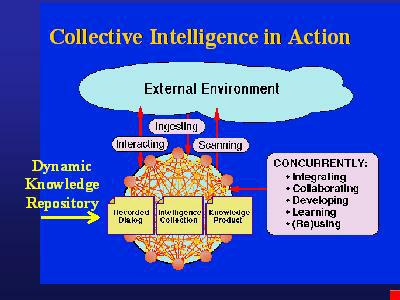 Fig. 1
Fig. 1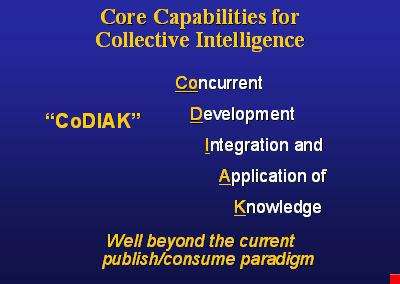 Fig. 2
Fig. 2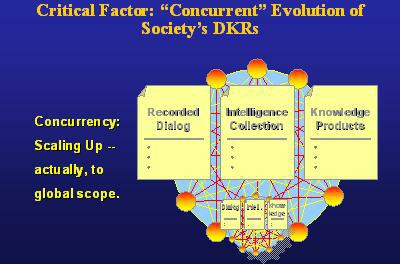 Fig. 3
Fig. 3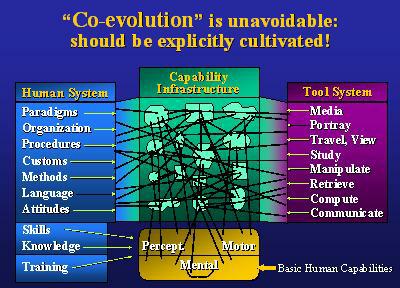 Fig. 4
Fig. 4 Fig. 5
Fig. 5 Fig. 6
Fig. 6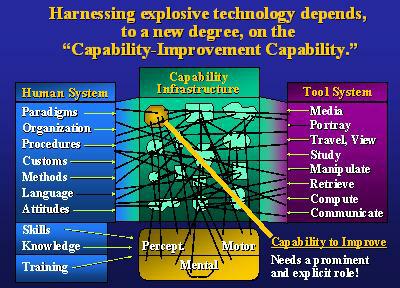 Fig. 7
Fig. 7 Fig. 8
Fig. 8
 Fig. 9
Fig. 9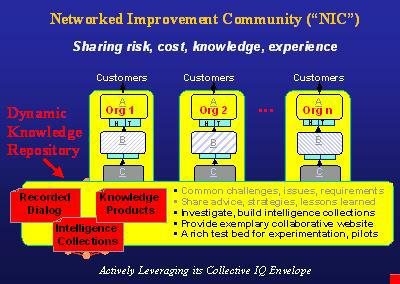 Fig. 10
Fig. 10 Fig. 11
Fig. 11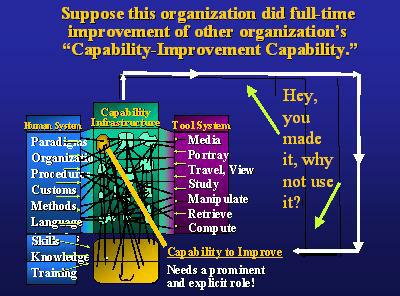 Fig. 12
Fig. 12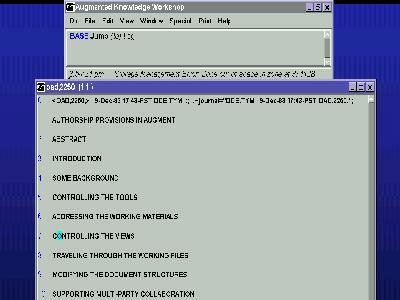 Fig. 13
Fig. 13
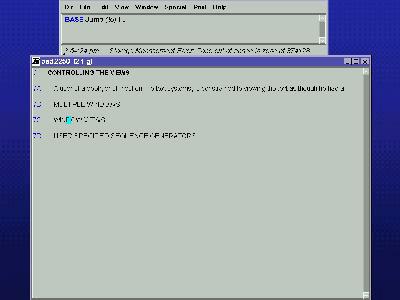 Fig. 14
Fig. 14
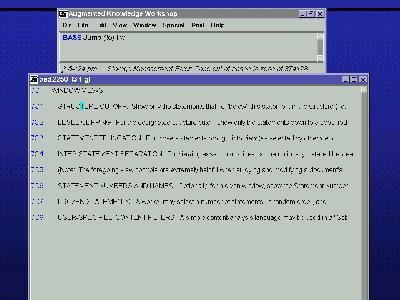 Fig.
15
Fig.
15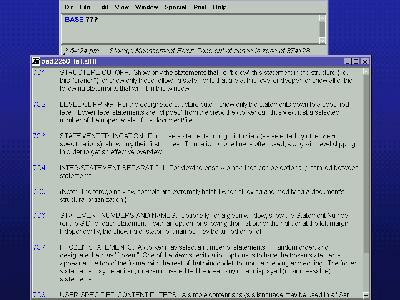 Fig. 16
Fig. 16
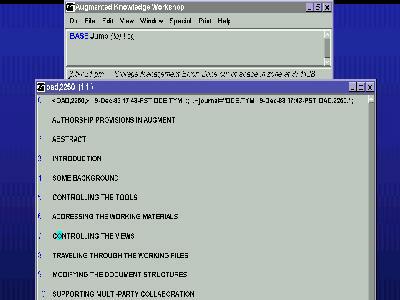 Fig. 17
Fig. 17
 Fig. 18
Fig. 18
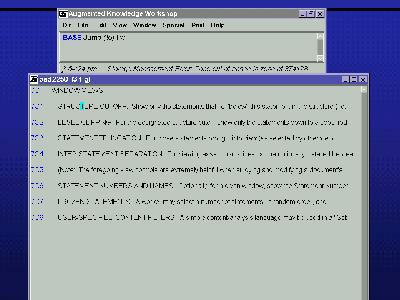 Fig. 19
Fig. 19
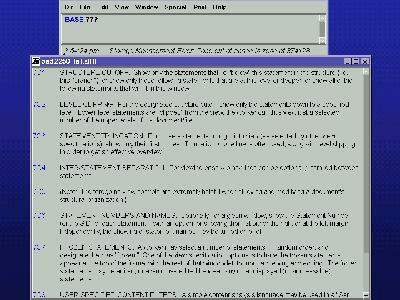 Fig. 20
Fig. 20